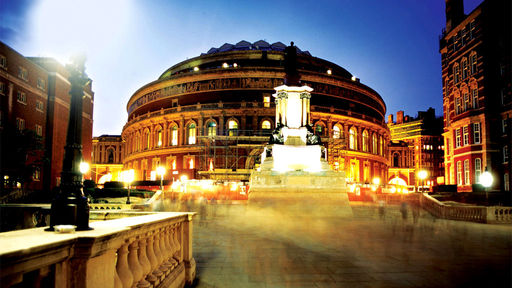
The Prom concert on August 24, by the London Symphony Orchestra and Chorus, conducted by Valery Gergiev, opened with Nagasaki by Alfred Schnittke, his graduation piece from the Moscow Conservatory. In this piece for chorus, solo mezzo-soprano, and large orchestra (including a theremin), Schnittke set texts reflecting on the devastation of the Japanese city by the atomic bomb at the end of the Second World War by Anatoly Sofronov, described in Calum MacDonald’s program notes as “the official Soviet propaganda poet”, along with poems by two Japanese poets, Eisaku Yoneda and Shimazaki Tōson.
Although the piece was accepted by the Moscow Conservatory, its finale was considered by the Soviet Composers Union as not optimistic enough (probably only a Soviet bureaucrat could demand from a piece about the aftermath of a nuclear attack); Schnittke was accused of having succumbed to”Expressionism” and “forgetting the principles of Realism in music.” Schnittke rewrote the finale, using additional text by his friend Gerogy Fere, and it was approved for performance, which is received in 1959. It was not performed again in Schnittke’s lifetime.
Since it is basically a student piece and from the 50’s, it is probably not surprising that Nagasaki has none of the extreme modernist and post-modernist“funny business” which one thinks about as being characteristic of Schnittke’s music. It’s a rather straight-forward, very strong, very accomplished, very effective piece, showing the influence of Shostakovich. The first movement, which seems a little as though it might be the beginning of the St. Matthew Passion as arranged by Shostakovich, lingers strongly in this listener’s memory.
The second half of the concert was the Eighth Symphony of Dimitri Shostakovich. It is so easy to think about Shostakovich only in terms of his being some kind of political football, that it is often a surprise to come in contact with a piece that, due to an absence of a sexy back story and simply by its sheer quality, makes you realize just what a good composer he was–especially what a brilliant orchestrator. It’s full of striking material and endlessly inventive orchestration, but also very sure in its construction, with a very tight dramatic trajectory. The quieter philosophical last movement and particularly the long gentle coda, with its very light texture featuring a series of instrumental solos accompanied with strikingly unexpected combinations of instruments, is especially memorable. Its hard to imagine either of these pieces receiving better performances than Gergiev and the LSO gave them.
 The late night Prom on August 25 consisted entirely of music by Michael Nyman performed by the Michael Nyman Band, including excerpts of his music for the Peter Geenaway’s movies The Draughtsman’s Contract and The Cook, The Thief, His Wife and Her Lover, along with two of the Six Celan Songs with soprano Anu Komsi, and the first performance of The Musicologist Scores, which has been commissioned by the BBC for this concert.
The late night Prom on August 25 consisted entirely of music by Michael Nyman performed by the Michael Nyman Band, including excerpts of his music for the Peter Geenaway’s movies The Draughtsman’s Contract and The Cook, The Thief, His Wife and Her Lover, along with two of the Six Celan Songs with soprano Anu Komsi, and the first performance of The Musicologist Scores, which has been commissioned by the BBC for this concert.
Nyman was trained as a composer, but in the 1960s, dismayed by the trends and tendencies of contemporary music, he stopped writing music and became a musicologist, being responsible for major editions of works of Purcell and Handel; as a critic he became especially interested in American experimental music and produced the major book Experimental Music: Cage and Beyond. Both of these interests became for him the doors into resuming composition.
Nyman’s music is heavily influenced by the harmonies and procedures of Baroque music–particularly repetitive ones, which intersect with techniques of early minimalism and early rock. Many of the pieces could be described as contrafacta of particular pieces, since they take progressions or bass lines and elaborate them over many repetitions.
The first movement of the four from The Draugtsman’s Contract is a good example of this practice; it takes the Prelude to Act 3 Scene 2 of Purcell’s King Arthur and recomposes it in a way that points of commonality between the Baroque work and rock and roll. The idea of morphing between periods and styles is a striking and interesting one. In this case the realization is not quite as successful. The texture of the work is always the same, involving the piano playing incessant blocky chords over the bass, while the strings play the same harmonies in an equally blocky way but faster. This texture is maintained almost universally throughout all the pieces and its effect is not lessened by its amplification, and it very quickly grows very tiring and about as soon loses all charm and interest, especially since the rhetorical shaping of the pieces is almost non existent–they more or less just start and keep going until they stop.
The new work, The Musicologist Scores, has a very interestingly ambiguous quality, suggesting, among other things, the possibility of some kind of semi pornographic opera. Alas, it was just more of the same. The title refers to Nyman himself, and his musicological work with works of Purcell and Handel, which are the sources of certain sections of the work. It is true that the compositional methods of Purcell, Handel, Bach, et al are consistent in all their works; in a way one might say that all there music is the same. The trick, and one of their great achievements, is to make pieces that may be made in the exactly the same way–over and over again–sound so different and differently expressive.
